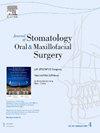The detection of distomolar teeth on panoramic radiographs using different artificial intelligence models
IF 1.8
3区 医学
Q2 DENTISTRY, ORAL SURGERY & MEDICINE
Journal of Stomatology Oral and Maxillofacial Surgery
Pub Date : 2024-11-14
DOI:10.1016/j.jormas.2024.102151
引用次数: 0
Abstract
Purposes
One notable anomaly, presence of distomolars, arises beyond the typical sequence of the human dental system. In this study, convolutional neural networks (CNNs) based machine learning methods were employed to classify distomolar tooth existence using panoramic radiography (PR).
Methods
PRs dataset, composed of 117 subjects with distomolar teeth and 146 subjects without distomolar teeth, was constructed. These images were assessed using AlexNet, DarkNet, DenseNet, EfficientNet, GoogLeNet, ResNet, MobileNet, NasNet-Mobile, VGG, and XceptionNet frameworks for distomolar teeth existence. Considering the moderate number dataset samples, transfer learning was also utilized to improve the performance of these CNN based networks along with 5-fold cross-validation. The final classification was obtained through the fusion of the classifiers results.
Results
Performance of the experimental studies was assessed utilizing accuracy (Acc), sensitivity (sen), specificity (spe) and precision (pre) metrics. Best accuracy value of 96.2 % was obtained for the fusion of DarkNet, DenseNet, and ResNet, three best individual performing architectures, in distomolar teeth classification problem.
Conclusion and Practical Implications
In summary, this study has demonstrated the significant potential of CNNs in accurately detecting distomolar teeth in dental radiographs, a critical task for clinical diagnosis and treatment planning. The fusion of CNN architectures, particularly ResNet, Darknet, and DenseNet, has shown exceptional performance, pointing towards the future of artificial intelligence (AI) driven dental diagnostics. Our findings showed that these systems can help clinicians during radiologic examinations.
使用不同的人工智能模型检测全景 X 光片上的远臼齿。
目的:远臼齿是一种明显的异常现象,它的存在超出了人类牙齿系统的典型序列。本研究采用基于卷积神经网络(CNNs)的机器学习方法,利用全景放射摄影(PR)对远磨牙的存在进行分类:方法:构建了由 117 名有远磨齿和 146 名无远磨齿受试者组成的 PRs 数据集。使用 AlexNet、DarkNet、DenseNet、EfficientNet、GoogLeNet、ResNet、MobileNet、NasNet-Mobile、VGG 和 XceptionNet 框架对这些图像进行了评估。考虑到数据集样本数量适中,还利用迁移学习和 5 倍交叉验证来提高这些基于 CNN 的网络的性能。最终的分类结果是通过融合分类器的结果得出的:利用准确度(Acc)、灵敏度(sen)、特异度(spe)和精确度(pre)指标评估了实验研究的性能。在远磨牙分类问题中,DarkNet、DenseNet 和 ResNet 这三个性能最好的单独架构的融合获得了 96.2% 的最佳准确率:总之,本研究证明了 CNN 在准确检测牙科 X 射线照片中的远磨齿方面的巨大潜力,而远磨齿是临床诊断和治疗计划中的一项关键任务。CNN 体系结构的融合,尤其是 ResNet、Darknet 和 DenseNet 的融合,显示出卓越的性能,为人工智能(AI)驱动的牙科诊断的未来指明了方向。我们的研究结果表明,这些系统可以在放射检查中帮助临床医生。
本文章由计算机程序翻译,如有差异,请以英文原文为准。
求助全文
约1分钟内获得全文
求助全文
来源期刊

Journal of Stomatology Oral and Maxillofacial Surgery
Surgery, Dentistry, Oral Surgery and Medicine, Otorhinolaryngology and Facial Plastic Surgery
CiteScore
2.30
自引率
9.10%
发文量
0
审稿时长
23 days
 求助内容:
求助内容: 应助结果提醒方式:
应助结果提醒方式:


